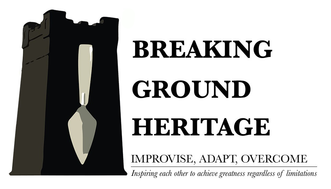Project Setup
Introduction
This resource has been developed by Breaking Ground Heritage (BGH), in conjunction with Operation Nightingale and draws upon 10 years’ experience of working with vulnerable members of society in heritage-based projects. This resource is not exhaustive and not all areas will be relevant to each project, however, it will give you some key considerations when developing a successful project of your own.
In our experience, the most successful projects have been delivered through a combination of a stimulating and exciting research, coupled alongside the ‘best fitting’ multidisciplinary staff. Staff who are able to bridge the gap between the ‘professional’s and the participants’ effortlessly and the methodology in place to measure success.
At the back of this toolbox are the key forms that we use at BGH, so we can better understand our participants needs prior to the start of the project and make any last minute adjustments should they be required. This is often followed up by a telephone conversation to clarify any points and to ensure that the participant is ready for the project. The forms also help evaluate how the project has gone.
Project setup
Wellbeing must be built into any projects during the initial planning stages, to ensure an effective project delivery and a realistic management of outcomes.
Project and site selections should consider the following:
- Is the site accessible?
- What mitigations can be put in place to make the site more accessible?
- Is the research accessible to all who wish to take part? If not, can it be made to be more accessible? Accessibility to facilities, educational barriers, specialist skills such as diving or GIS etc.
- Does the site or project naturally foster social/group cohesion? Will you be living in a friendly campsite environment with social elements naturally embedded or does the project promote isolation or lone working?
- Is the site or project stimulating?
Staffing a project
It is essential to the success of the project and the wellbeing and safety of the staff and participants that the correct staff members (or staff with the right skills) are selected.
- Select your essential criteria at the start and recruit accordingly
- Do you have sufficient staff to run the wellbeing element of the project?
- Have you enough staff robustness, that should a member of staff be unavailable, the project is still able to continue in their absence?
- Do the staff have the correct qualifications/training for the intended participant group? Mental Health First Aid (MHFA), British Sign Language (BSL), working with offenders, employment/education advise or Disclosure for working with minors.
- Are staff experienced enough in working with or alongside vulnerable groups?
- Are the staff that you have selected people focused?
- Do the staff understand the need for meeting the wellbeing outcomes?
- Do all project staff understand what the project is trying to achieve in addition to the research brief?
- Are your staff able to be proactive and improvise where necessary, so that people with physical limitations can participate? e.g. If access to the site is getting wet and boggy, are you able to be creative (but safe) to ensure participants with mobility issues can to get to site. This could simply be by using a vehicle to traverse the poor ground.
Considering Outcomes
Deliverable Outcomes
These outcomes are what will determine if the project has been a success from a wellbeing perspective. It is important to be as realistic as possible when identifying your projects outcomes and consider carefully what additional assets you may require, for achieving more ambitious outcomes.
- What are the primary outcomes that you want to deliver through your project? e.g. Increased wellbeing, improved social networks, better employability prospects, better health, community ownership of a site?
- Consider the measures/indicators that will be used to evaluate outcomes. Use the attached basic logic model to assist in this process.
- Each outcome will need to be carefully considered and assessed as to its feasibility of being meaningfully met in the project.
- By the adaptation or development of simple components in a project, is it possible to widen initial deliverable outcomes.
- What additional assets/staff will you require for your outcomes
- Will the outcome benefit the participants/project or is it just included to meet a grant /terms condition?
- Are there any secondary outcomes? E.g. improved employability skills, CPD, socialising more.
- Have you capacity within the scope of the project to work on individuals’ goals where applicable? e.g. I want to be more confident in my section drawing or I would like to learn how to plan an exhibition.

